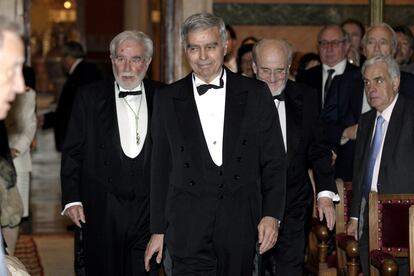The member of the Royal Spanish Academy (RAE) Antonio Fernández Alba and one of the most important Spanish architects of the second half of the 20th century died this Tuesday in Madrid at the age of 96, this institution has reported. Elected on December 16, 2004 for the o chair, he took possession of it on March 12, 2006 with the speech titled Words about the city that is born, in which he reflected on language and urban change. That idea was the prelude to his work in the RAE, that of “trying to bring the voice of the city to the place where words are created,” he said. Born in Salamanca, on December 17, 1927, Fernández Alba, the only architect of the current Plenary of the RAE and the first to join it, was awarded the National Prize for Architecture in 1963 and the National Prize for Restoration in 1981. Also a member of the Royal Academy of Fine Arts of San Fernando since 1986, he was linked to the El Paso group and belonged to a generation of architects linked to art who, he claimed, “tried to incorporate modernity into the dark era of the fifties and sixties in Spain.”
Graduated from the Madrid School of Architecture in 1957, Fernández Alba considered himself a “son of reason”, who was critical of issues such as real estate speculation in large cities and architects with pretentiousness: “Savage capitalism is anarchically resolving spaces, where the citizen only counts as a number.” He also exercised this criticism in the thirty articles that he published in EL PAÍS, in which he dealt with issues such as the teaching of architecture, the work of Gaudí or urban planning.
Professor of Elements of Composition at the Higher Technical School of Architecture of the Polytechnic University of Madrid, he was a doctor Honorary by the universities of Valladolid, Alcalá de Henares and the Polytechnic of Cartagena. He was the short-lived director of the Research Center for New Expressive Forms (Cinfe), dependent on the Ministry of Culture, in 1977, which, in his words, was created to “promote institutions, workshops and group or individual activities.” However, he resigned five months later due to the “difficulties in developing” the plan he had envisioned.
In 1984 he was appointed director of the Board of Trustees of the Spanish Museum of Contemporary Art (MEAC). Also from that year until 1987 he headed the Institute for Conservation and Restoration of Artistic Heritage and was also part of the Board of Trustees of the Prado Museum (1996-1999). ). In his work as an architect he dealt mainly with institutional buildings, such as the restorations of the Rollo convent (1958-1962) in Salamanca, for which he received the National Award for Architecture, and that of the National Astronomical Observatory, which he did. deserving of the National Restoration Award. But Fernández Alba was above all responsible for the recovery of the old San Carlos Hospital for its transformation into the Reina Sofía National Art Center Museum, a commission that was given to him in 1979 but from which he disassociated himself in the final section, before its inauguration in 1986. He was also the author of the restoration of the Plaza Mayor of Salamanca (1983).
Among his most relevant works are the Faculty of Law of the Autonomous University of Madrid, with its large lobby with skylight; Also in the capital, the M-30 Mortuary and the Biological Research Center of the Higher Council for Scientific Research (CSIC); the House of Culture of Vitoria and the Polytechnic Building of the University Campus of Ciudad Real. Among the awards received, the Gold Medal for Architecture (2002) also stands out, of which he was awarded for “the constructive excellence of his work and his constant commitment.”
Additionally, he was the author of books such as The design between theory and praxis (1971), Domus Aurea. Dialogues in Virgil’s house (1997), De varia restoratione: interventions in architectural heritage (1999), Standard spaces. Places of invention (2000), The wounded city (2001), El Escorial, metaphor in stone (2004) y The springs of Ilion (2010). In 2016, she published On the threshold of the word. Urban environment, spaces and places of the headquarters of the Royal Spanish Academy, first work dedicated entirely to the institutional building, inaugurated in 1894. From 2018 it is Locus civitatis: metropolitan writings and other affinities. His last works were Closed Autumn Blues (2021), Boulders (2022) y Dawns break (2023).
This reflection remains to be remembered, premonitory of defining features, in part, of today’s society: “We are witnesses, in the city of information, of a growing set of signs, of ephemeral artifacts, fleeting stories and hasty memories of the “narcissistic logic of consumption, in a neutralizing compulsion, in a media schizophrenia that splits one’s own subjectivity.”

